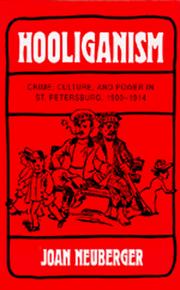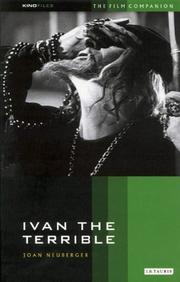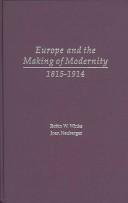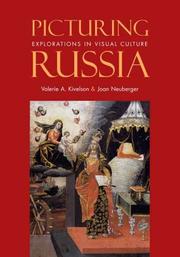| Listing 1 - 8 of 8 |
Sort by
|

ISBN: 0520080114 0520913078 0585115451 9780520913073 9780585115450 9780520080119 Year: 1993 Volume: 19 Publisher: Berkeley University of California press
Abstract | Keywords | Export | Availability | Bookmark
 Loading...
Loading...Choose an application
- Reference Manager
- EndNote
- RefWorks (Direct export to RefWorks)
In this pioneering analysis of diffuse underclass anger that simmers in many societies, Joan Neuberger takes us to the streets of St. Petersburg in 1900-1914 to show us how the phenomenon labeled hooliganism came to symbolize all that was wrong with the modern city: increasing hostility between classes, society's failure to "civilize" the poor, the desperation of the destitute, and the proliferation of violence in public spaces.
Crime --- Hoodlums --- Social Welfare & Social Work --- Social Sciences --- Criminology, Penology & Juvenile Delinquency --- Saint Petersburg (Russia) --- Social conditions. --- 343.9 <09> --- 343.9 <47> --- -Hoodlums --- -Hooligans --- Thugs (Hoodlums) --- Criminals --- Gangs --- City crime --- Crime and criminals --- Crimes --- Delinquency --- Felonies --- Misdemeanors --- Urban crime --- Social problems --- Criminal justice, Administration of --- Criminal law --- Criminology --- Transgression (Ethics) --- Criminologie: geschiedenis --- Criminologie --(algemeen)--Rusland. Sovjet-Unie --- Social aspects --- -Social conditions --- -Criminologie: geschiedenis --- 343.9 <47> Criminologie --(algemeen)--Rusland. Sovjet-Unie --- 343.9 <09> Criminologie: geschiedenis --- -343.9 <09> Criminologie: geschiedenis --- Hooligans --- Saint Petersburg (R.S.F.S.R.) --- Pietari (Russia) --- Peterburi (Russia) --- Peterburg (Russia) --- Piter (Russia) --- St. Petersburg (Russia) --- Petersburg (Russia) --- Sankt-Peterburg (Russia) --- Санкт-Петербург (Russia) --- Sanktpeterburg (Russia) --- Санктпетербург (Russia) --- Saint-Pétersbourg (Russia) --- San Pietroburgo (Russia) --- Petroupolis (Russia) --- Petropolis (Russia) --- Hoods (Hoodlums) --- Petrograd (R.S.F.S.R.) --- Leningrad (R.S.F.S.R.)

ISBN: 1860645607 Year: 2003 Volume: 9 Publisher: London : I.B. Tauris,
Abstract | Keywords | Export | Availability | Bookmark
 Loading...
Loading...Choose an application
- Reference Manager
- EndNote
- RefWorks (Direct export to RefWorks)
Book
ISBN: 1501732773 9781501732775 9781501732782 1501732781 9781501732768 Year: 2019 Publisher: Ithaca, NY
Abstract | Keywords | Export | Availability | Bookmark
 Loading...
Loading...Choose an application
- Reference Manager
- EndNote
- RefWorks (Direct export to RefWorks)
Sergei Eisenstein's unfinished masterpiece, Ivan the Terrible, was no ordinary movie. Commissioned by Joseph Stalin in 1941 to justify state terror in the sixteenth century and in the twentieth, the film's politics, style, and epic scope aroused controversy even before it was released. In This Thing of Darkness, Joan Neuberger offers a sweeping account of the conception, making, and reception of Ivan the Terrible that weaves together Eisenstein's expansive thinking and experimental practice with a groundbreaking new view of artistic production under Stalin. Drawing on Eisenstein's unpublished production notebooks, diaries, and manuscripts, Neuberger's riveting narrative chronicles Eisenstein's personal, creative, and political challenges and reveals the ways cinematic invention, artistic theory, political critique, and historical and psychological analysis went hand in hand in this famously complex film. Neuberger's bold arguments and daring insights into every aspect of Eisenstein's work during this period, together with her ability to lucidly connect his wide-ranging late theory with his work on Ivan, show the director exploiting the institutions of Soviet artistic production not only to expose the cruelties of Stalin and his circle but to challenge the fundamental principles of Soviet ideology itself. Ivan the Terrible, she argues, shows us one of the world's greatest filmmakers and one of the 20th century's greatest artists observing the world around him and experimenting with every element of film art to explore the psychology of political ambition, uncover the history of recurring cycles of violence and lay bare the tragedy of absolute power.
Motion pictures --- Political aspects --- Ivan --- Stalin, Joseph, --- Eisenstein, Sergei, --- In motion pictures. --- Influence. --- Criticism and interpretation. --- Ivan Groznyĭ (Motion picture) --- Ivan the Terrible (Motion picture) --- Djougatchvili, Iossif Vissarionovitch, --- Джугашвили, Иосиф Виссарионович, --- Dzhugashvili, Iosif Vissarionovich, --- Koba, --- Shih-tʻai-lin, --- Sidalin, --- Ssu-ta-lin, --- Stalin, Giuseppe, --- Сталин, И. В. --- Stalin, I. V. --- Сталин, Иосиф, --- Stalin, Iosif, --- Сталин, К., --- Stalin, K., --- Staline, --- Staline, Joseph, --- Staljin, J. V., --- Sutārin, --- Soselo, --- Stalini, Ioseb Besarionis że, --- Sṭalin, Y. Ṿ., --- Sṭalin, Y., --- Stalin, Josef, --- Stalin, Josef Vissarionovich, --- סטאלין, יאסיף, --- סטאלין, י. --- סטאלין, י. וו --- סטאלין, י. װ. --- סטאלין, י., --- סטלין, יוסיף ויסאריונוביץ׳, --- סטלין, יוסף --- 斯大林, --- Stalin, Jossif Vissarionovitš, --- Sztálin, Joszif, --- Istālīn, Yūsīf Vīsāryūnūvīch, --- استالين، يوسيف ويساريونووتج, --- Σταλιν, Ιωσηφ, --- Stalin, Ιōsēph, --- Eisenstein, Sergei M., --- Eisenstein, Sergej, --- Эйзенштейн, Сергей Михайлович, --- Ėĭzenshteĭn, Sergeĭ Mikhaĭlovich, --- Айзенштайн, Сергей Михайлович, --- Aĭzenshtaĭn, Sergeĭ Mikhaĭlovich, --- Ejzenštejn, --- Ejzenštejn, S. M., --- Еисенстеин, Сергей Михайлович, --- Eisenstein, Sergeĭ Mikhaĭlovich, --- Ejzenstein, --- Ejzenstein, S. M., --- Eisenstein, --- Eisenstein, Serge, --- Eisenstein, S. M., --- Ejzenštejn, Sergej, --- Eisenstein, S. --- Эйзенштейн, С. М. --- Ėĭzenshteĭn, S. M. --- Aisan̲sṭin̲, Cerji, --- Aizenshṭain, Sergai, --- איזנשטיין , סרגיי --- Eisenstein, Serguei M., --- Eizenstein, Sergei, --- Ioannes Basilides, --- Joannes Basilides, --- Jwan Wasilowitz, --- Iwan Wasilowitz, --- Ivan, --- Iwan --- Iwan, --- Īoann, --- Īoann Vasilʹevich, --- Groźny, Iwan, --- Groznyĭ, Ivan, --- Ivan Vasilʹevich, --- Иван --- Jughashvili, Ioseb, --- Jughashvili, Ioseb Vissarionovich, --- Jughashvili, Koba,

ISBN: 0822327805 Year: 2002 Publisher: Durham ; London Duke University Press
Abstract | Keywords | Export | Availability | Bookmark
 Loading...
Loading...Choose an application
- Reference Manager
- EndNote
- RefWorks (Direct export to RefWorks)

ISBN: 0195156226 Year: 2005 Publisher: Oxford : Oxford university press,
Abstract | Keywords | Export | Availability | Bookmark
 Loading...
Loading...Choose an application
- Reference Manager
- EndNote
- RefWorks (Direct export to RefWorks)

ISBN: 9780300119619 0300119615 Year: 2008 Publisher: New Haven (Conn.) : Yale University Press,
Abstract | Keywords | Export | Availability | Bookmark
 Loading...
Loading...Choose an application
- Reference Manager
- EndNote
- RefWorks (Direct export to RefWorks)
What can Russian images and objects& a tsar's crown, a provincial watercolor album, the Soviet Pioneer Palace& tell us about the Russian people and their culture? This wide-ranging book is the first to explore the visual culture of Russia over the entire span of Russian history, from ancient Kiev to contemporary, post-Soviet society. Illustrated with more than one hundred diverse and fascinating images, the book examines the ways that Russians have represented themselves visually, understood their visual environment, and used visual images in social and political contexts. Expert contributors discuss images and objects from all over the Russian/Soviet empire, including consumer goods, architectural monuments, religious icons, portraits, news and art photography, popular prints, films, folk art, and more. Each of the concise and accessible essays in the volume offers a fresh interpretation of Russian cultural history. Putting visuality itself in focus as never before, 'Picturing Russia' adds an entirely new dimension to the study of Russian literature, history, art, and culture. The book enriches our understanding of visual documents and shows the variety of ways they serve as far more than mere illustration.
Art and history. --- Art, Russian. --- Visual communication. --- Russia
Book

ISBN: 1618112139 9781306490955 1306490952 9781618112132 9781618112125 1618112120 9798887193656 Year: 2013 Publisher: Boston, MA
Abstract | Keywords | Export | Availability | Bookmark
 Loading...
Loading...Choose an application
- Reference Manager
- EndNote
- RefWorks (Direct export to RefWorks)
This two-volume reader is intended to accompany undergraduate courses in the history of Russian cinema and Russian culture through film. Each volume consists of newly commissioned essays, excerpts from English language criticism and translations of Russian language essays on subtitled films which are widely taught in American and British courses on Russian film and culture. The arrangement is chronological: Volume one covers twelve films from the beginning of Russian film through the Stalin era; volume two covers twenty films from the Thaw era to the present. General introductions to each period of film history (Early Russian Cinema, Soviet Silent Cinema, Stalinist Cinema, Cinema of the Thaw, Cinema of Stagnation, Perestroika and Post-Soviet Cinema) outline its cinematic significance and provide historical context for the non-specialist reader. Essays are accompanied by suggestions for further reading. The reader will be useful both for film studies specialists and for Slavists who wish to broaden their Russian Studies curriculum by incorporating film courses or culture courses with cinematic material. Volumes one and two may be ordered separately to accommodate the timeframe and contents of courses. Volume one films: Sten'ka Razin, The Cameraman's Revenge, The Merchant Bashkirov's Daughter, Child of the Big City, The Extraordinary Adventures of Mr. West in the Land of the Bolsheviks, Battleship Potemkin, Bed and Sofa, Man with a Movie Camera, Earth, Chapaev, Circus, Ivan the Terrible, Parts I and II. Volume two films: The Cranes are Flying, Ballad of a Soldier, Lenin's Guard, Wings, Commissar, The Diamond Arm, White Sun of the Desert, Solaris, Stalker, Moscow Does Not Believe in Tears, Repentance, Little Vera, Burnt by the Sun, Brother, Russian Ark, The Return, Night Watch, The Tuner, Ninth Company, How I Ended This Summer. Authors: Birgit Beumers, Robert Bird, David Bordwell, Mikhail Brashinsky, Oksana Bulgakova, Gregory Carlson, Nancy Condee, Julian Graffy, Jeremy Hicks, Andrew Horton, Steven Hutchings, Vida Johnson, Lilya Kaganovsky, Vance Kepley, Jr., Susan Larsen, Mark Lipovetsky, Tatiana Mikhailova, Elena Monastireva-Ansdell, Joan Neuberger, Vlada Petrić, Graham Petrie, Alexander Prokhorov, Elena Prokhorova, Rimgaila Salys, Elena Stishova, Vlad Strukov, Yuri Tsivian, Meghan Vicks, Josephine Woll, Denise J. Youngblood
Motion pictures --- PERFORMING ARTS / Film & Video / History & Criticism. --- Cinema --- Feature films --- Films --- Movies --- Moving-pictures --- Audio-visual materials --- Mass media --- Performing arts --- History --- History. --- History and criticism. --- History and criticism --- Russia --- Russie --- Rossīi︠a︡ --- Rossīĭskai︠a︡ Imperīi︠a︡ --- Russia (Provisional government, 1917) --- Russia (Vremennoe pravitelʹstvo, 1917) --- Russland --- Ṛusastan --- Russia (Tymchasovyĭ uri︠a︡d, 1917) --- Russian Empire --- Rosja --- Russian S.F.S.R. --- Russia (Territory under White armies, 1918-1920) --- Battleship Potemkin. --- Bed and Sofa. --- Chapaev. --- Child of the Big City. --- Circus. --- Earth. --- Eastern Europe. --- Extraordinary Adventures of Mr. West in the Land of the Bolsheviks. --- Ivan the Terrible. --- Man with a Movie Camera. --- Russia. --- Soviet. --- Stalin. --- Sten'ka Razin. --- The Cameraman's Revenge. --- The Merchant Bashkirov's Daughter. --- aesthetics. --- analysis. --- art. --- cinema. --- culture. --- film. --- history. --- motion pictures. --- movies. --- silent film.
Book

ISBN: 1282751956 9786612751950 1400821339 1400811651 9781400821334 Year: 1994 Publisher: Princeton, NJ
Abstract | Keywords | Export | Availability | Bookmark
 Loading...
Loading...Choose an application
- Reference Manager
- EndNote
- RefWorks (Direct export to RefWorks)
The popular culture of urban and rural tsarist Russia revealed a dynamic and troubled world. Stephen Frank and Mark Steinberg have gathered here a diverse collection of essays by Western and Russian scholars who question conventional interpretations and recall neglected stories about popular behavior, politics, and culture. What emerges is a new picture of lower-class life, in which traditions and innovations intermingled and social boundaries and identities were battered and reconstructed. The authors vividly convey the vitality as well as the contradictions of social life in old regime Russia, while also confronting problems of interpretation, methodology, and cultural theory. They tell of peasant death rites and religious beliefs, family relationships and brutalities, defiant peasant women, folk songs, urban amusement parks, expressions of popular patriotism, the penny press, workers' notions of the self, street hooliganism, and attempts by educated Russians to transform popular festivities. Together, the authors portray popular culture not as a static, separate world, but as the dynamic means through which lower-class Russians engaged the world around them. In addition to the editors, the contributors to this volume are Daniel R. Brower, Barbara Alpern Engel, Hubertus F. Jahn, Al'bin M. Konechnyi, Boris N. Mironov, Joan Neuberger, Robert A. Rothstein, and Christine D. Worobec.
Folklore --- Popular culture --- Peasants --- Working class --- Folk beliefs --- Folk-lore --- Traditions --- Ethnology --- Manners and customs --- Material culture --- Mythology --- Oral tradition --- Storytelling --- Culture, Popular --- Mass culture --- Pop culture --- Popular arts --- Communication --- Intellectual life --- Mass society --- Recreation --- Culture --- History --- Russia --- Soviet Union --- Social life and customs
| Listing 1 - 8 of 8 |
Sort by
|

 Search
Search Feedback
Feedback About UniCat
About UniCat  Help
Help News
News